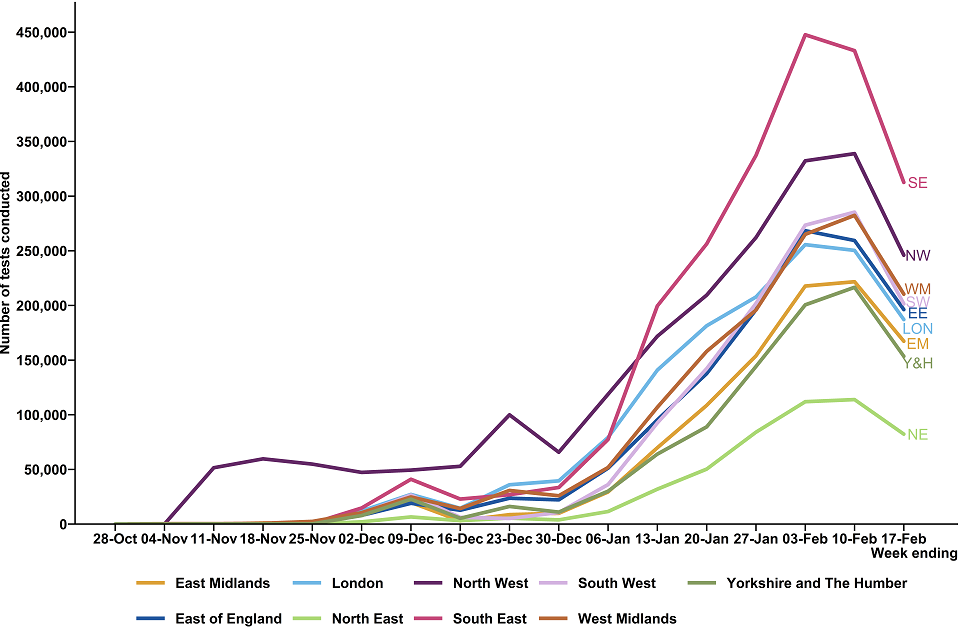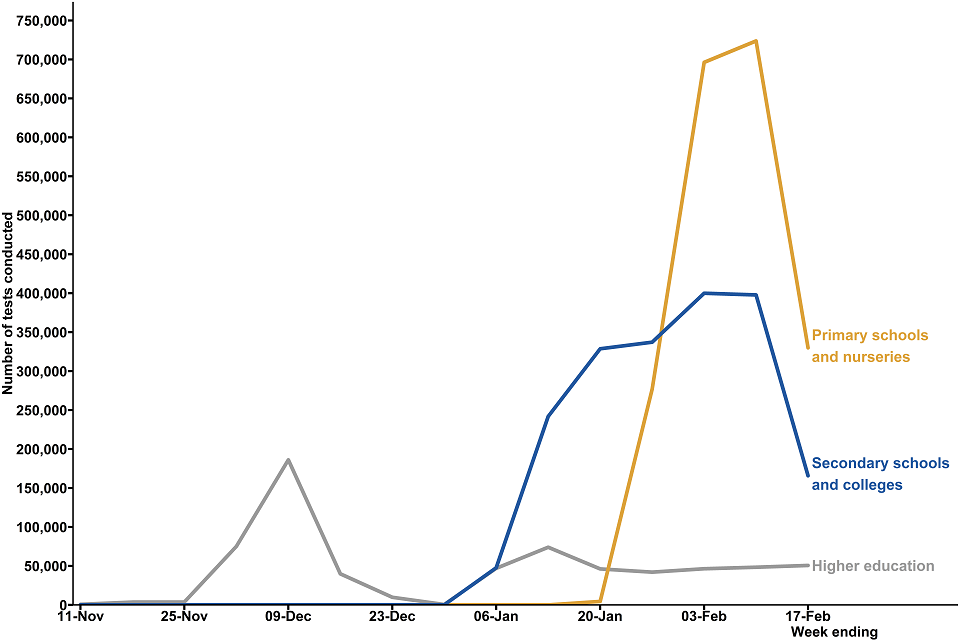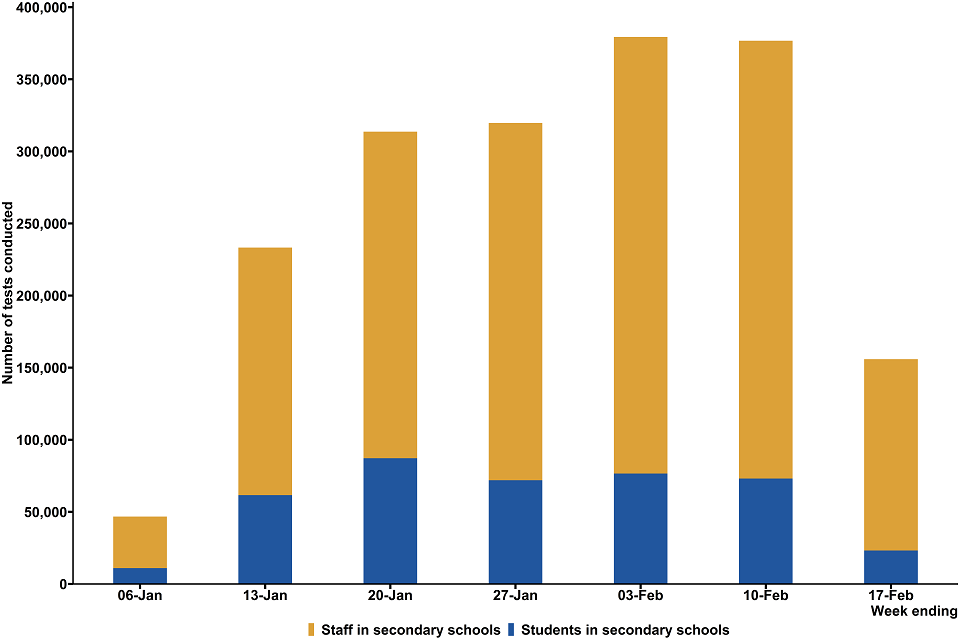Weekly statistics for rapid asymptomatic testing in England: 11 February to 17 February 2021
Updated 25 February 2021
Applies to England
This week figures on lateral flow device testing in education settings are included in this publication for the first time.
Introduction
This statistical publication aims to provide information on rapid testing for people without COVID-19 symptoms in England. This includes:
- the number of LFD tests conducted in England by test result
- the number of LFD tests conducted in England by region
- the number of LFD tests conducted in England in education settings
This publication focuses on rapid testing using lateral flow device (LFD) tests, however polymerase chain reaction (PCR) tests are included where appropriate for comparison. All data used in the report can be found in the ‘Tests conducted’ data tables on the weekly collection page. This includes information on both LFD and PCR tests at lower tier local authority level.
The figures in this report are not deduplicated and refer only to the number of tests taken, not the number of people tested. Because people can have more than one test, the data should not be compared with prevalence or case positivity rates.
The figures in this report include LFD tests which were registered through the National Testing Programme digital infrastructure. They do not currently include LFD tests conducted where the tests were not registered via this route. LFD tests for the majority of secondary care NHS staff and some testing within the private sector testing are therefore not included.
See the About this data section below for more information.
Background
Types of tests
PCR tests
PCR tests check for the genetic material of the coronavirus in the sample, which is taken using a swab and is processed in a lab via a polymerase chain reaction (PCR). This type of test is predominantly used for anyone who has symptoms, or to confirm a positive LFD test result in certain use cases, including:
- self-reporting LFDs[footnote 1]
- cross channel hauliers
Lateral flow device tests
LFD tests, often referred to as rapid tests, test for the presence of proteins called ‘antigens’ which are produced by the virus. They are swab tests that give results in 30 minutes or less, without the need for processing in a laboratory. These tests are primarily used for those who do not have symptoms.
From 21 October 2020, LFD tests were made available in limited capacity except where rapid testing pilots were conducted. Since then, their availability has expanded to a broader range of settings.
Rapid testing for people without symptoms
Rapid testing using LFD tests is currently being offered to people who do not have symptoms, in a range of different settings.
Some LFD testing is carried out at asymptomatic test sites, which are deployed in a range of community settings such as universities, schools, care homes and workplaces. They are also set up by local authorities as part of the community testing program. Testing at these sites is assisted: a person will take a swab test under the supervision of a trained operator who then processes the test then reads and records the result.
Some LFD testing is carried out entirely by individuals themselves (that is an individual takes their own test, unassisted, and reports their own result), however in these specific situations (see the Types of tests section above) if a positive test result is returned the individual is required to take a confirmatory PCR test. For more information see understanding lateral flow tests for people without symptoms.
LFD tests conducted, England[footnote 2]
The number of LFD tests conducted has been increasing overall since their introduction in October 2020. In the latest week (11 February to 17 February), 1,756,402 LFD tests were conducted, which is 13 times higher than mid-December. However, there has been a reduction in LFD tests since the previous week, which coincides with school half-term.
In comparison, in the latest week 1,116,433 PCR tests were conducted. This is the fourth successive week for which more LFD tests were conducted than PCR tests. Previously the number of PCR tests conducted had always been higher than LFD tests. This reflects the increasing use of LFD tests, as well as a decrease in symptomatic people taking a PCR test due to decreasing COVID-19 prevalence.
PCR and LFD tests have different uses and are therefore applied in different situations (see the Types of tests section above for more information). The primary purpose of rapid LFD testing is to identify people with COVID-19 who do not have symptoms. As the number of LFD tests conducted increases, more asymptomatic positive cases are identified earlier and therefore they are less likely to transmit the virus to their contacts.
Of the LFD tests conducted in the latest week, 5,626 tests returned a positive result, and 1,748,744 tests returned a negative result. Since LFD tests were introduced, 86,970 positive results and 12,139,157 negative results have been reported.
Figure 1: number of LFD and PCR tests conducted, England

This data can be found in the ‘table_1’ and ‘table_2’ tabs of the ‘Tests conducted: 28 May 2020 to 17 February 2021 data tables’ on the weekly collection page.
LFD tests conducted by region, England
The number of LFD tests conducted has been increasing overall across all regions between late December 2020 and the beginning of February 2021, however all regions have decreased in the latest week, which coincides with half-term. Between 11 February and 17 February 2021, the most LFD tests were conducted in the South East followed by the North West, similar to previous weeks.
Figure 2: LFD tests conducted by region, England[footnote 3]

This data can be found in the ‘table_4’ tab of the ‘Tests conducted: 28 May 2020 to 17February 2021 data tables’ on the weekly collection page.
LFD tests conducted in education settings, England
The rapid testing operation has been rolled out differently across the different education settings, as summarised in the table below. For more information see the background on testing in education settings section below.
| Testing started | Frequency | Group tested | |
|---|---|---|---|
| Primary schools, school-based nurseries and maintained nursery schools | 18 January 2021 | Twice a week | Staff |
| Secondary schools and colleges | 4 January 2021 | Once a week then increased to twice a week | Staff and students* |
| Higher education | 27 November 2020 | Twice before leaving and twice on return | Staff and students |
| Higher education | 25 January 2021 | Twice a week | Staff and students |
*Testing of secondary school students only includes children of critical workers and those in vulnerable groups who are currently attending school.
LFD tests conducted by phase of education
The number of LFD tests conducted within primary schools, school-based nurseries and maintained nursery schools increased substantially between 14 January 2021 and the beginning of February to over 700,000 tests. However, in the latest week this has declined to 329,841 tests, which coincides with half term. 747 positive test results were returned in the latest week within primary schools and nurseries, a decrease from 1,322 positive results in the previous week.
Similarly, within secondary schools and colleges, the number of LFD tests conducted has increased gradually since the week commencing 31 December 2020 to almost 400,000 in the week commencing 4 February. This has declined to 165,674 LFD tests in the latest week, which coincides with half term. The number of positive test results has been decreasing since the week commencing 14 January 2021 with 121 returned in the latest week compared to 341 in the previous week.
50,659 LFD tests were conducted in the latest week in higher education which has remained broadly consistent since the beginning of January. The number of LFD tests conducted in higher education peaked between 3 December to 9 December 2020 which coincides with students getting tested to enable them to travel home for the winter break. There has been a decrease in positive results in higher education seen over the past month, with 121 positive test results returned in the latest week.
The number of positive test results is not published as a proportion of the total tests conducted due to the data quality. In addition, because there are differences in the testing operation between the different phases of education, they cannot be directly compared. See the data quality section below for more information.
Figure 3: number of LFD tests conducted in education, by phase of education, England

This data can be found in the ‘table_6’ tab of the ‘Tests conducted: 28 May 2020 to 17 February 2021 data tables’ on the weekly collection page.
LFD tests conducted by staff and students in secondary schools[footnote 4]
In the latest week 132,715 LFD tests were taken by staff in secondary schools, in comparison with 23,198 tests taken by students. The number of tests conducted by secondary school staff has increased rapidly since the beginning of January, however had declined in the latest week which coincides with half-term. Tests conducted by secondary school students have remained broadly stable over the past 3 weeks however they have decreased in the latest week, which coincides with half-term.
Figure 4: number of LFD tests conducted by staff and students in secondary schools, England

This data can be found in the ‘table_7’ tab of the ‘Tests conducted: 28 May 2020 to 17 February 2021 data tables’ on the weekly collection page.
Background on rapid testing in education settings
Primary schools, school-based nurseries and maintained nursery schools
Since 18 January 2021, on-site staff in primary schools, school-based nurseries, and state-maintained nurseries have been able to take an LFD test twice weekly at home. Primary and nursery staff self-report their test result, therefore if an individual receives a positive result, they are then required to take a confirmatory PCR test. Primary school students are not currently being tested.
For more information see the NHS Test and Trace statistics methodology.
Secondary schools and colleges
LFD testing within secondary schools and colleges was implemented for on-site staff from 4 January 2021. Staff were expected to take a test once a week initially, however the guidance was updated at the start of the national lockdown to twice-weekly testing for those staff attending schools and colleges. All staff testing will resume from 8 March.
Due to the national lockdown only students currently attending secondary schools and colleges are children of critical workers and vulnerable groups. These students are tested twice within their first week back, 3 days apart, and then encouraged to test twice weekly for those students in attendance for the duration of lockdown. This testing will be expanding to all students in attendance from 8 March.
For more information visit mass testing for secondary pupils. Testing in secondary schools and colleges is currently assisted via the use of an asymptomatic test site.
Higher education
Rapid LFD testing was implemented from 27 November 2020 in higher education providers to support a strategy to enable students to safely travel home for the winter break. Tests taken prior to this were part of testing pilots. Testing has continued into the spring term with LFD tests made available to both on-site staff and students via an asymptomatic testing site. Students currently eligible to return to their provider are expected to be tested twice on their return and twice weekly thereafter. On-site staff are also expected to be tested twice weekly.
For more information on testing in higher education please see the guidance on Students returning to, and starting higher education in Spring Term 2021.
See the ‘Rapid asymptomatic testing section’ for more information on self-report testing and asymptomatic test sites.
About this data
Lateral flow device tests were first made available from 21 October 2020 in England. This data contains LFD tests reported through the existing National Testing Programme digital infrastructure and does not include LFD tests conducted where the tests were not registered via this route that is used to collect data for this report.
The following use cases for LFD tests are not currently reporting results digitally into Test and Trace systems, and therefore are excluded from this report:
- testing for the majority of NHS secondary care staff
- testing for some staff in private sector industries
In these cases, test results should be reported directly into Public Health England. In future, all LFD tests will be reported via the existing National Testing Programme digital infrastructure and will be included.
A full explanation of the data sources and methods used to produce these statistics can be found in the NHS Test and Trace statistics methodology.
Data quality
Given the importance of this service and the commitment of NHS Test and Trace to be open and transparent with the public it serves, this data is being released at the earliest possible opportunity. However, this data should be treated with caution whilst the understanding of the data and its quality improves.
The requirement for care home staff to register negative LFD test results was suspended between 31 December 2020 and 15 January 2021 inclusive, following a change in guidance issued on 23 December 2020 to increase testing in care home staff. As a result, a proportion of LFD tests conducted on care home staff will not be included for these dates.
An LFD test produces a result on the device almost immediately, without it being automatically recorded, therefore some results might not be captured. For settings where self-reporting LFD testing procedures[footnote 5] are in place, it is likely that the number of tests conducted are underreported. It is however their statutory duty to do so, and easier reporting tools are being rolled out to support these individuals to report their tests as quickly and efficiently as possible. It is possible that tests with a negative result are more likely to be affected, therefore it is not advisable to calculate a positivity rate with the data.
Positive test results are not published as a proportion of the total number of tests conducted. There are several reasons why it is not advisable to calculate a positivity rate with this data:
-
the number of tests conducted is not deduplicated and refers to the number of tests taken and not the number of people tested. Because people can have more than one test, the number of tests conducted therefore cannot be compared with prevalence or case positivity rates
-
rapid testing is primarily used for repeat testing of asymptomatic individuals and the frequency of testing varies across different settings, therefore positivity rates would not be directly comparable
-
the potential underreporting of tests conducted by individuals self-reporting is more likely to affect negative test results than positives thus skewing any positivity rate calculation
More information on data limitations and how the figures in this publication can and can’t be used is outlined in the NHS Test and Trace statistics methodology.
Future developments
We continue to explore the feasibility of adding new breakdowns to the publication on rapid testing to support user needs. Over the coming months, we intend to make data available on the following:
- rapid testing for asymptomatic NHS staff
- asymptomatic testing in care homes
- rapid testing in public and private industries
- community testing programme
For feedback and any further questions, please contact statistics@dhsc.gov.uk.
-
Self-reported results from LFDs are where the individual carrying out the test on themselves is expected to report their own test and subsequent result. ↩
-
Counts of LFD tests conducted do not include tests which weren’t reported through the National Testing Program digital infrastructure. ↩
-
Absolute number of tests conducted in each region and does not take into consideration population of regions. ↩
-
Staff and students are identified using age as a proxy; therefore it is not appropriate to breakdown tests in universities by staff and student using this methodology. ↩
-
Self-reporting LFDs are where the individual carrying out the test on themselves is expected to report their own test and subsequent result. ↩
